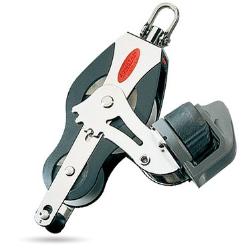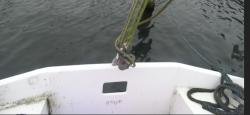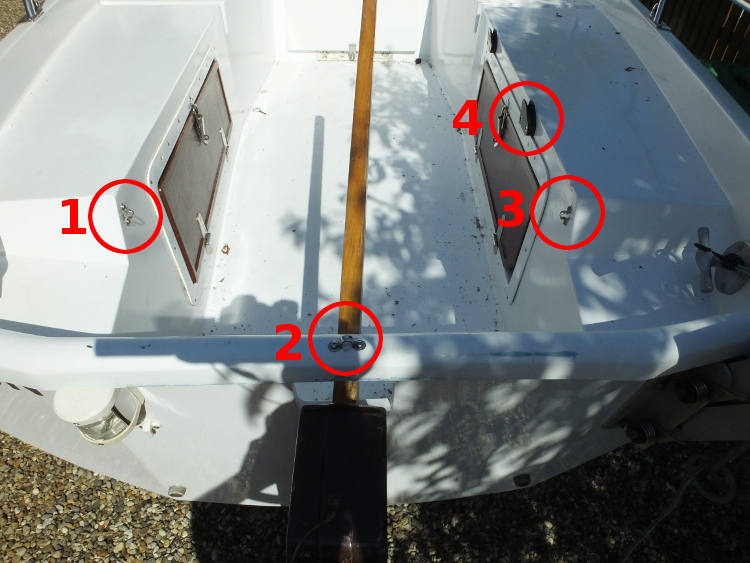Boom rigging
|
|
Hi all,
I was preparing my yacht today for the boom to be assembled to the mast and came across a couple of things I was unsure of. (Sorry if some of the terms are incorrect, newbie here :)) at the end of the boom there is a pulley system, I was under the impression that this controls the swing of the boom and attached to the transom. But I'm also under the impression that also on the end of the boom it will have some rope that goes to a pulley at the top of the mast then secured at the bottom on a cleat? I seem to have a lot of pulleys, I think I have more than I need and this is confusing me.  << this pulley system is already attached to the end of the boom but the rope seems to be a bit long for just controls, so I thought maybe this is the one that goes up to the mast and another set of pulleys will be for controls?? << this pulley system is already attached to the end of the boom but the rope seems to be a bit long for just controls, so I thought maybe this is the one that goes up to the mast and another set of pulleys will be for controls??
Please advise and the help is greatly appreciated :D Thanks |
|
|
Hi
The pulley system on the end of the boom is the mainsheet that controls the angle of your boom relative to the hull when sailing. The combined block (pulley) and cleat attachs to an eye on the transom. You need a lot of rope (the 'sheet') because when you have the boom right out (when the wind is coming from behind you) the rope runs out over the blocks it 'multiplies' according to how many blocks in the system. In your case you need four times as much rope as the distance from the end of the boom to your hand holding the sheet. Three times for the blocks and another for the distance from the block to your hand. You need the blocks to give you the power to control the sail using your hands. The rope from the end of the boom to the top of the mast is called a 'topping lift'. It is used to support the end of the boom (and the weight of the sail) when you are moored. Without the topping lift you would have the furled sail and boom in your lap! Hope this helps. Study the photos in the rigging section and you will see how the mainsheet is rigged. I think yours is a later boat with the single transom eye, but Greg might be along shortly to correct me. Brian |
|
|
This post was updated on .
Hi Brian,
The photograph that Mark wants is at: https://www.seahawk17.org.uk/boat-description-rigging.php#mainsheet and scroll down to the "Moores" section. As you suggest, Mark's boat appears to have the later (or user-fitted) option of a block with cleat, correctly fitted to be attached at the transom.
Greg Chapman
GregAfloat - My Boating Biography |
|
|
Thanks Greg
I'm not a big fan of jamming cleats on mainsheets - the cause of many a nasty broach in squally winds. Brian |
|
|
Hi Brian,
Ian, who crewed for my only successful completion of the Three Rivers Race, was at a stall in a Boat Jumble and came across a a cleat similar to Mark's and asked why he was selling it. As I recall the story he was told, he was sailing a SeaHawk off Wells-Next-the-Sea, with his main cleated. He saw dinghies to windward, flipping over but was too slow to release the sheet from the cleat before the squall hit him too. That was the only time he'd been in a yacht that had been laid flat and he determined it would never happen again, so that's why the block and cleat were for sale. I remember the story because it's also the only time I have heard of a SeaHawk going beyond that point at around 45° beyond which she will not - normally - tip, no matter how hard the wind blows. Being a Broads sailor, perhaps that's because I've never had a long conversation with a SeaHawk owner with coastal experience?
Greg Chapman
GregAfloat - My Boating Biography |
|
|
I've been hit by squalls in Cornwall that would have laid anything flat. I saw a Shrimper flattened two years ago and that was in the Camel Estuary! That's why I don't like jamming cleats on the mainsheet on any boat under 25 feet. Having said that I once sailed a Westerly Warwick for 10 miles with the lee scuppers under water in a force 7 with the mainsheet cleated and the sail track jammed solid. Very exciting but somewhat stupid - I was 24 at the time though...........
|
|
|
In reply to this post by brian johnson
That's spot on, I hadnt thought about the pulleys multiplying the ropes length. And thanks for the description of the topping lift.
Much appreciated |
|
|
In reply to this post by mjseahawk
Dear all,
Yesterday I registered as I have since a couple of months a seahawk. The website is great and very clear. There is however a small problem I would like to ask your help. Hopefully I will be able to sail next week, but don’t know how to work with the pulleys that are along with the boom and the . I figured out I have a reedcraft version (quite sure it is #122) and would be pleased if someone would send some pictures how they attach the pulleys to an eye on the transom. I bought a new combined block (pulley) and cleat in one, but have no idea how the rope will run then – probably to the boom and then back? ? But what about the small eye on the middle of the stern? 
The picture of the website does not show well what is in the red circle; - I suppose a pulley and a cleat – is thattrue? I have the eye like it is in the blue circle and bought something that looks like this:  But that was because of the old situation; and now I know more about the boat and have more confidence in the old way; especially as I made new eyes! On the website it can be seen that the Moore-version has it like this as well, but is it strong enough for my almost 50 year old Reedcraft version? Below the old situation when I bought the boat.  I don’t think this is strong enough when there is hard wind and really would like to know your opinion. I am in doubt to swap the new pulleys with cleat for some pulleys and a cleat. What do you think? Thanks in advance! Kind regards, Joop de Jong |
|
|
This post was updated on .
Hi Joop,
No! What you see is a simple single block (pulley). There is no cleat there. A cleat has to be fitted on the first fixing after the sheet leaves the helmsman's hand.  Here's a better picture of the main sheet anchorage points on a Reedcraft boat which helps put what you can see in the original picture in context...  First, note that the eye's are simple flat strips of metal bent to form an arch. The end of the main sheet is fixed at Point 1. The sheet then rises to the boom where there is a double block. From there is falls to Point 2, where it passes round a single block to return to the second pulley within the block shackled to the boom. From there is passes to Point 3 where there is another single pulley. The helmsman (my brother) has the main sheet cleated at Point 4. The cleat is one I fitted. I do not believe that Reedcraft (or Moore) ever supplied a cleat for the main sheet, though many owners do fit one. If you look at Item 13 on the page at: http://www.seahawk17.org.uk/boat-description-rigginginstructions.php you'll see that I fitted my main sheet in exactly the opposite way round to that suggested by Reedcraft. As I describe further down the page, Moore's abandoned the four point anchorage for the main sheet and only used the boom and transom as anchorage points. Here's a closer picture of the boat seen there that shows what I now believe is the standard Moore's configuration. Note that the main sheet passes from the helmsman to the block on the boom and not to the transom.  You'll see that the eye on the transom on Moore's boats is made from heavy-gauge rod bent into a U shape and welded to a connecting strip, so it is much more substantial than those fitted to Reedcraft boats. Understandable, as it had to take three times the strain of the fittings on Reedcraft boats. If you do wish to use the fitting you have bought then note the design of the block on the transom of "Eos". You'll need one like that attached to your boom as that will hold the fixed end of the sheet. You can then use your fitting on the transom, with the sheet then passing to your hand. Your image is too small to see clearly whether your eye has been upgraded to cope with the extra strain. (I generally recommend uploading images that are 750px wide, so one can see any necessary detail. There's a FAQ on images at: https://forum.seahawk17.org.uk/Inserting-Images-in-the-Forum-td1599211.html )
Greg Chapman
GregAfloat - My Boating Biography |
«
Return to Help Desk
|
1 view|%1 views
| Free forum by Nabble | Edit this page |

